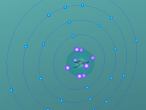Neon Atom
The atom being researched is Neon. It is the 10th element in the Periodic Table. It was discovered in 1898 by William Ramsay and Morris Travers at Universiity College London. The name comes from the Greeek 'Neos,' meaning 'new'. It is a rare gaseous element that, when in a vacuum discharge tube, emits a reddish-orange glow.
Below is a 3D model of a Neon atom.
As it is the 10th element, Neon has 10 protons (purple) in its nucleus, and in the most common isotope, 10 neutrons (green) as well. It has this same number of electrons (blue) that orbit the nucleus - 2 in the first energy level and 8 in the second. Like every other atom, its protons and neutrons each weigh 1 amu, and the electrons only 0.0006 amu, a unit for measuring atomic mass (extremely small). the total atomic mass of Neon's most common isotope is 20.18 amu.
The largest use for neon gas is in advertising signs. Neon is also used to make high voltage indicators and is combined with helium to make helium neon lasers. Liquid Neon is used as a cryogenic refrigerant (used to help make very low temperatures).
Neon belongs to the Noble Gas group (Group 0 on the periodic table) which are rare gases which exhibit great stability and extremely low reaction rates. It is the 4th most abundant element in the universe, and the 5th most abundant gas in air. It can be obtained from air by liquid distillation. At room temperature, its state is gas, however it can exist as a solid, liquid and plasma as well. It has a melting point of -249°C and a boiling point of -246.7°C. It's density is 0.0009cm/cm^3. It appears colourless under low pressure, however it flouresces (glows) when an electrical current passes through it. It is odourless, tasteless and is soluble in water. Neon does not react with any other substances and has no stable compounds.
Further information:
http://www.chemicalelements.com/elements/ne.html
http://www.rsc.org/periodic-table/element/10/neon
http://www.elementalmatter.info/neon-properties.htm
http://www.chemicool.com/elements/neon.html#appear
I would like to find out why Neon isn't a part of any compounds. I also want to know why it glows and more about the method used to obtain it from the air.
At the beginning of the workshop, I was going to model a Titanium atom. After learning the basics of programming, I found that Titanium, having 22 protons and electrons and 26 neutrons, was very difficult and time-consuming. I then chose Neon as an alternative because it had far less protons etc., so it took less time to finish. I also had much difficulty making the energy levels on which the electrons sit rotate (spin) around the nucleus, so I left that feature out of the model.























